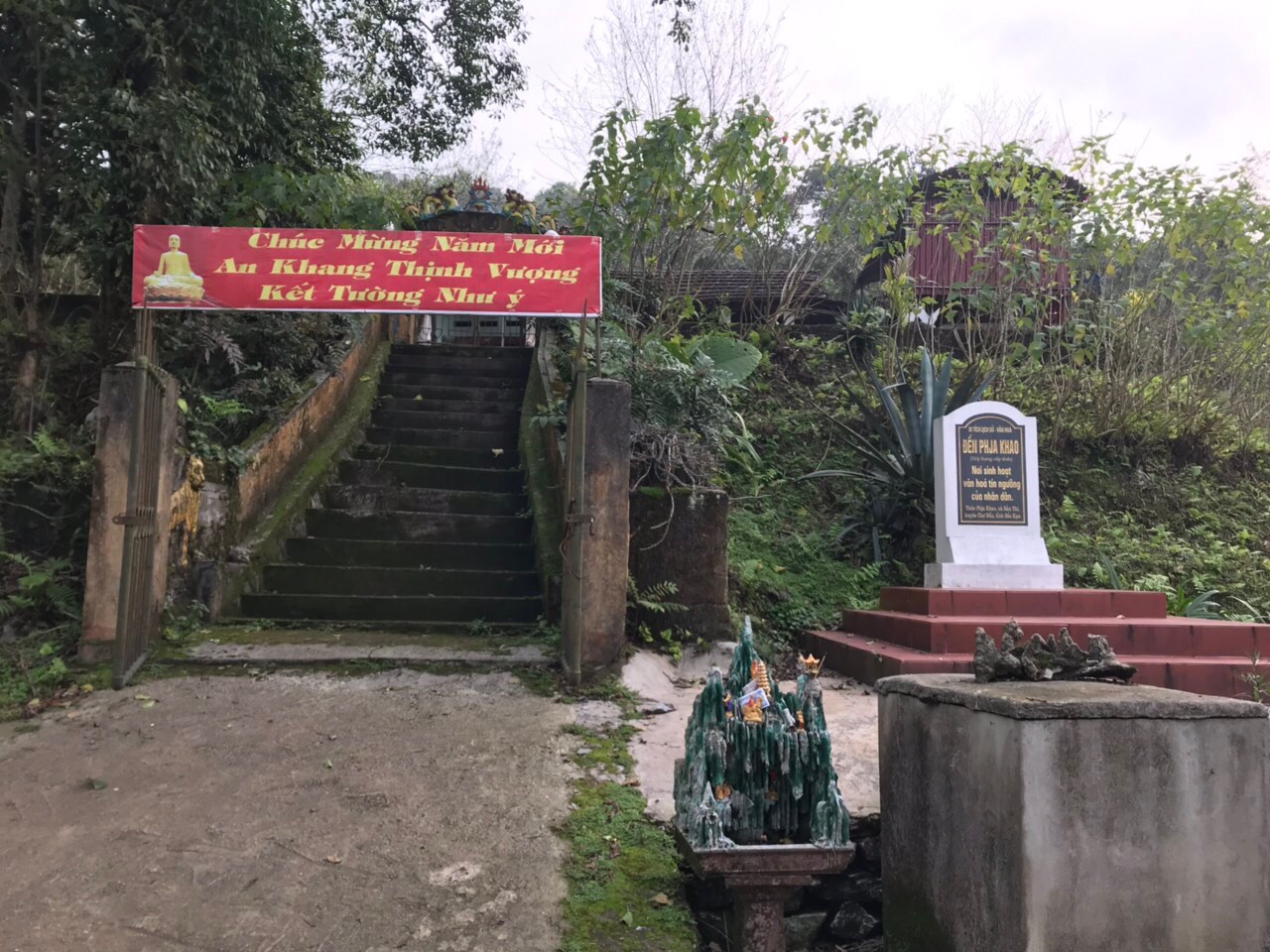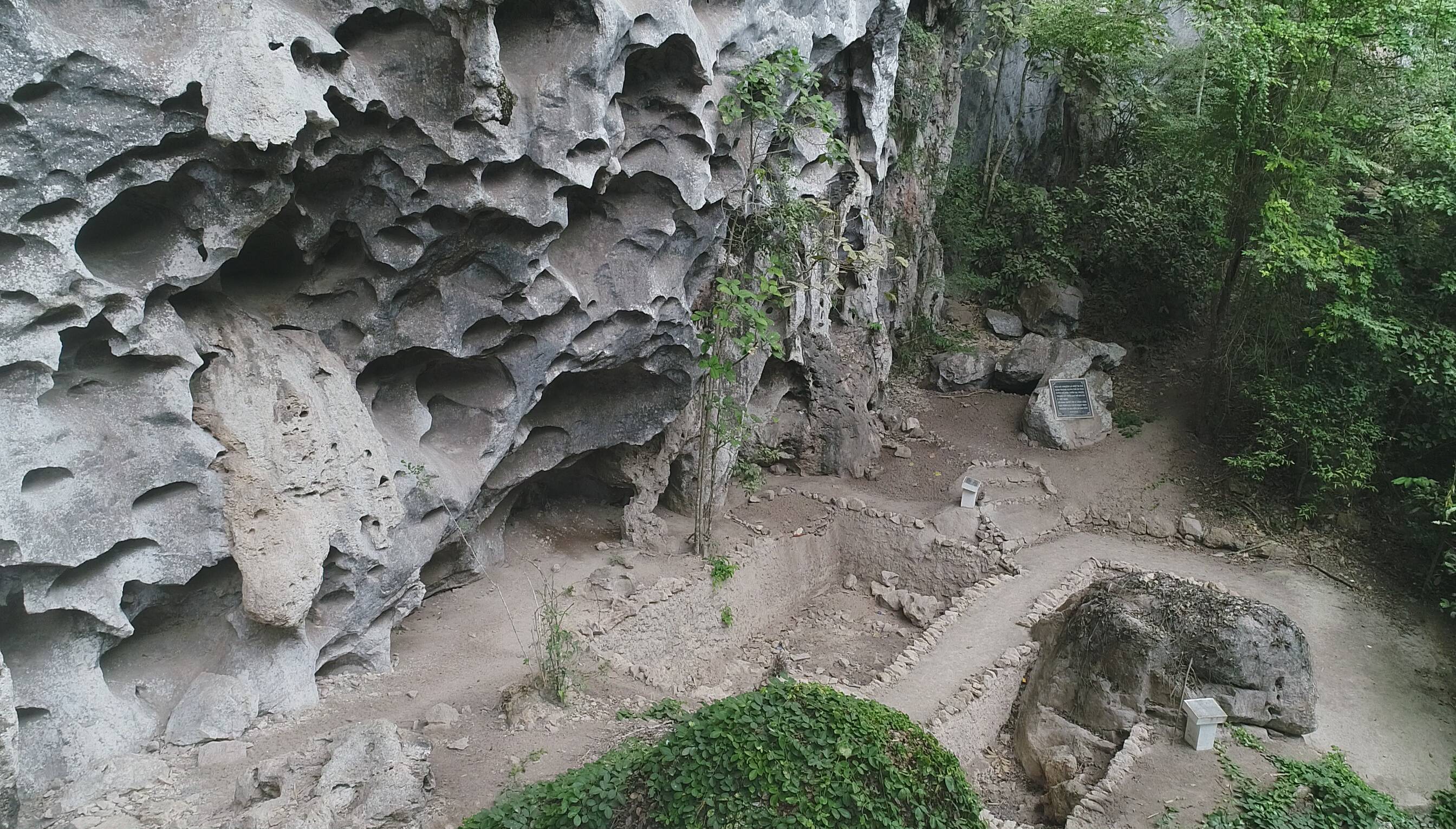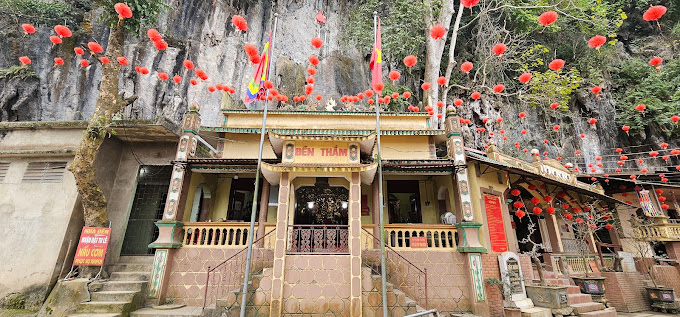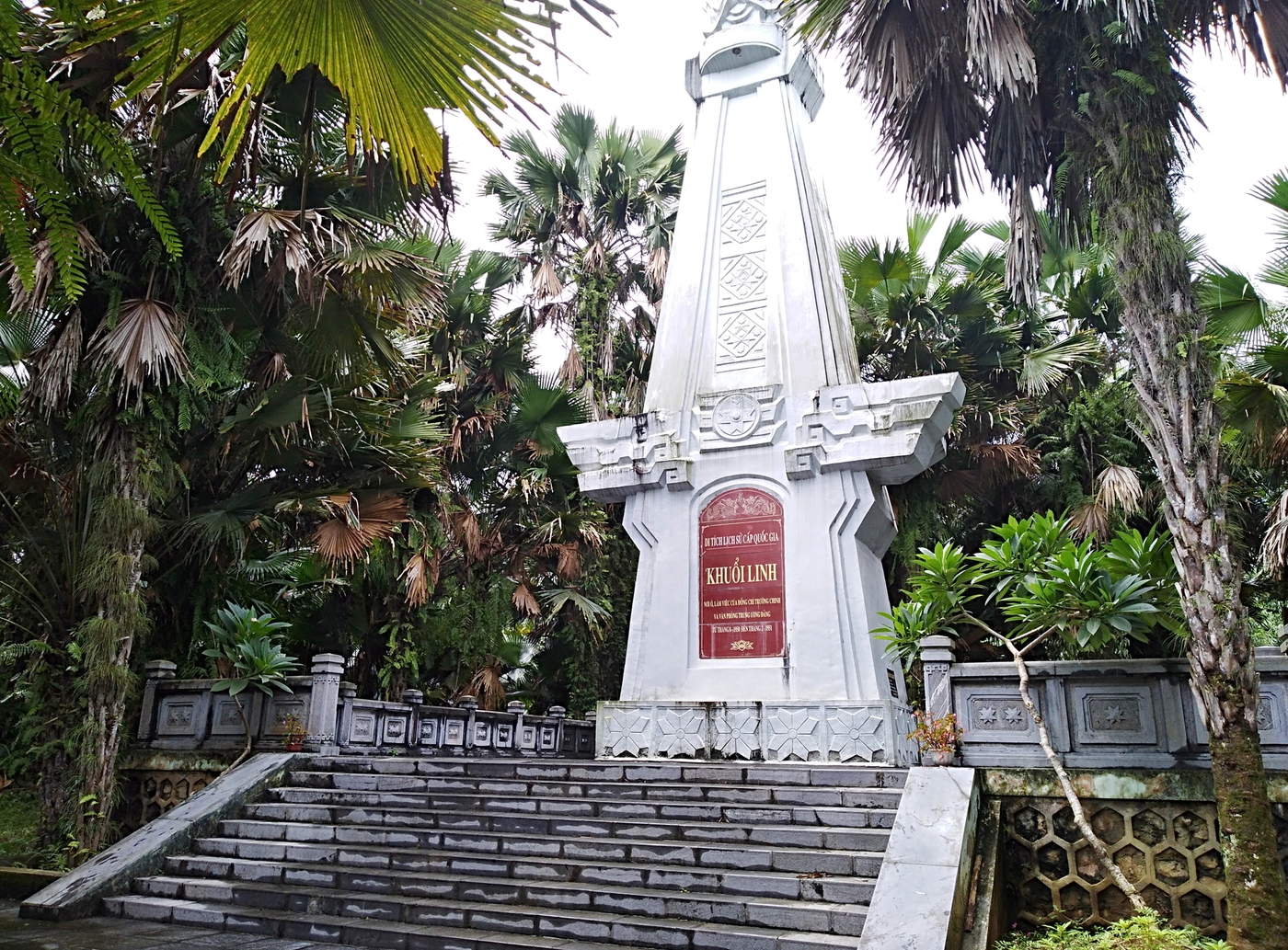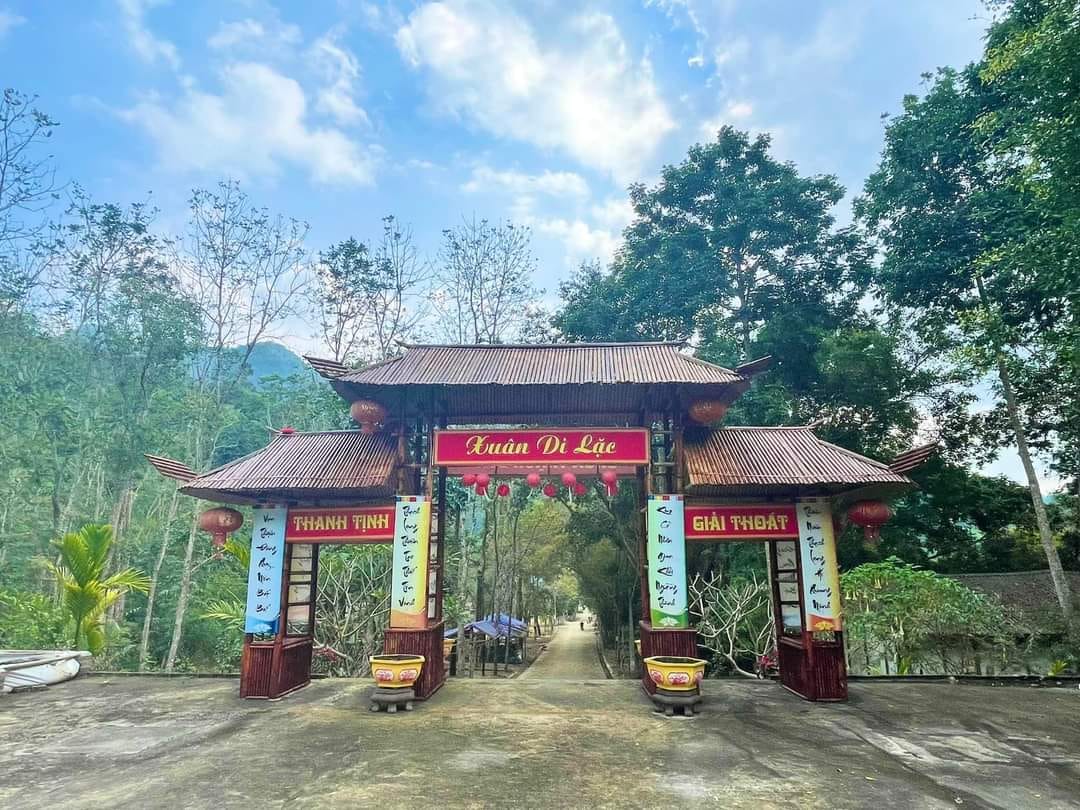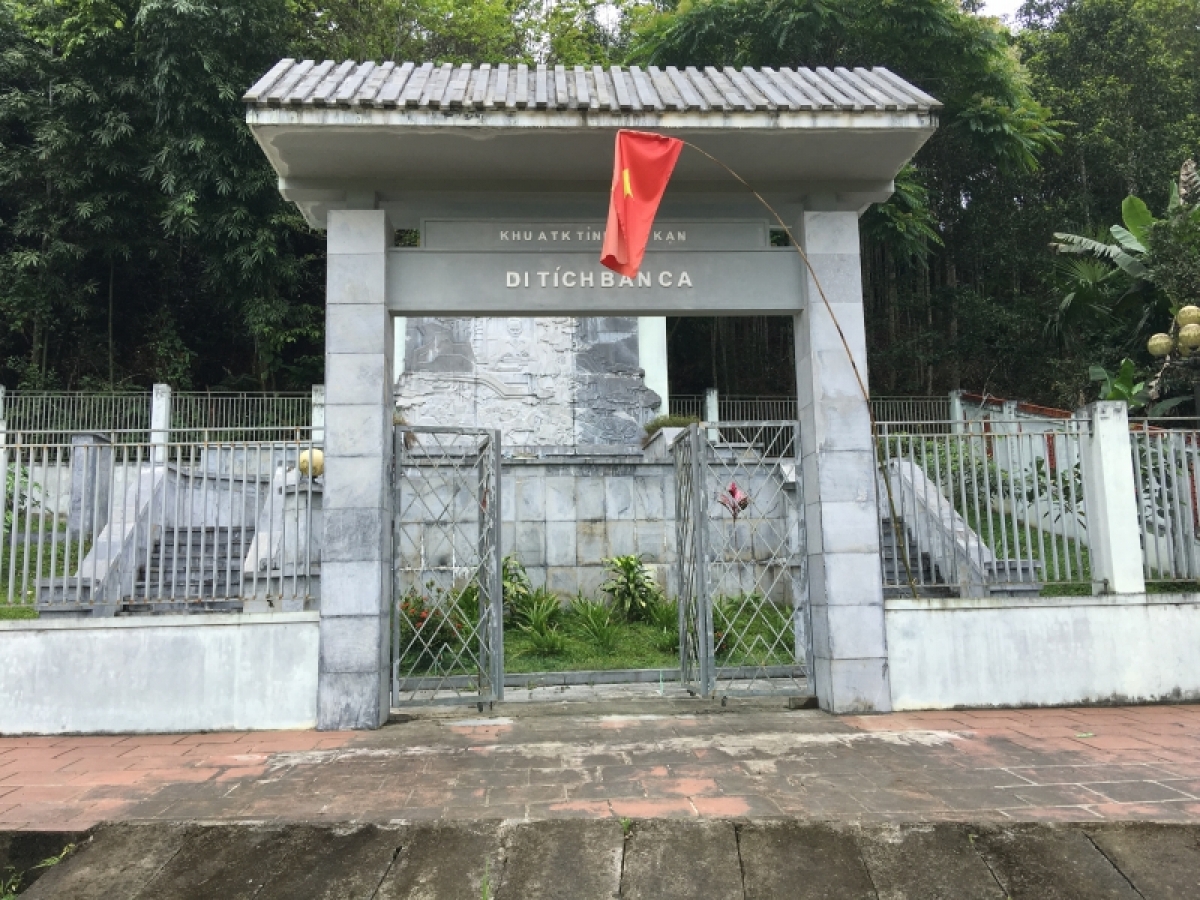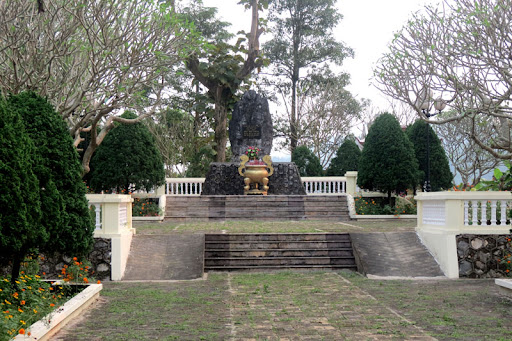Relic point Vietnam
Việt NamLocation for establishing the Youth Volunteer Team
Historical relic The location of the establishment of the Central Youth Volunteer Work Team (July 15, 1950) is located at Go Tho hill, Yen Lang commune, Dai Tu district, Thai Nguyen province. The establishment of the Central Youth Volunteer Work Team is a milestone marking the maturity of the Vietnamese Youth Volunteer Force in the nation's long resistance war against foreign invaders, marking its activities. The actions and dedication of many generations of officials and young people during the resistance war against the French colonialists. Currently, the location is where spiritual and cultural activities of officials and people of Dai Tu district and of Vietnamese officials and youth take place. The relic site was invested and built by the Ho Chi Minh Communist Youth Union Central Committee in 2002 on the occasion of the 52nd anniversary of the traditional Youth Volunteer Day. The relic site has 5 categories of works, monuments, memorial houses, and stele marking events, including: - Youth Volunteer Monument Area: located in the central and highest position of the Monument Area. The cluster of statues is the image of two young volunteers in the side-by-side position of the winner, symbolizing heroic indomitable will on a monolithic stone pedestal. The statue is about 5m high, the stone pedestal is 2.5m high, and about 2m wide. - Statue system area: Includes 8 statues made of monolithic stone carving heroes representing Vietnamese Youth: Ly Tu Trong (1931), Kim Dong (1943), Tran Van On (1950), Vo Thi Sau (1952), Nguyen Van Troi (1964), Nguyen Viet Xuan (1964), Doan Thi Lien (1966), Kpa Klong (1975). - Traditional House Area: The traditional house has a total area of 516 m², in the middle of the house there is a 1.5m high, 0.8m wide stele with a semi-arc shaped forehead, the front is covered with engraved red granite. Golden letters: "Our youth have made many good achievements and deserve to be Heroic Youth of a Heroic nation." - Main gate of the monument and fence system: Including the main gate and open fence in front of the monument. At the main gate, there is a monument nameplate made of monolithic granite material. The relic site has historical value, the first place of origin of the birthplace of the Vietnamese youth volunteer force in Thai Nguyen province, connected to other historical sites related to volunteerism in the Viet Bac region. and the whole country. With the above typical value, the location of the establishment of the Central Youth Volunteer Team (July 15, 1950), Thai Nguyen province, was ranked as a national historical relic by the Minister of Culture, Sports and Tourism. Join on February 24, 2023. Source: Department of Cultural Heritage
Thai Nguyen 3229 view
Phja Khao Temple
The Phja Khao temple project was built by local people on the top of Phja Khao mountain, Ban Thi commune, Cho Don district since 1933. This is a familiar place of spiritual cultural activities, long associated with daily life. of local people. Phja Khao Temple worships Saint Tran, who had the merit of defeating the Mongol invaders in the 13th century to maintain the peace of the country and people. Worshiping the mine workers who were killed by the French colonialists. In 2017, the temple was recognized as a provincial historical-cultural relic. Phja Khao peak has many lead and zinc mines, which are historical evidence of the exploitation of the French colonialists against Ban Thi mine workers, from 1909 - 1941. Here more than a hundred years ago, when the Indochina Mining and Metallurgical Company invested a lot of capital in the mine, especially building a cable car more than 3km long and a railway to transport ore. It is known that during its prosperity, the mine had up to 5,000 workers and 80 secretaries. By 1942, there were only 500 workers and 5 European managers. Within 27 years (1914 - 1941), France brought home over 350,000 tons of zinc ore. Phja Khao was a place that brought profit to the colonists, and was also a place where many complex elements gathered, where robberies and killings often occurred. On top of Phja Khao, about 15 meters from the relic site, is a deep abyss that, according to indigenous people, cannot be seen from the top of the abyss to the bottom because it is foggy all year round. That's where the French colonialists threw sick coolies (miners) or people who dared to protest down from the mountains. There are resorts of the French colonialists here, where mine management staff relax. The resort was built 100 years ago and is now just ruins, trees have grown over the walls, creating an ancient, mossy look. Peace returned here, there were no longer mines or resorts of the French colonialists. Phja Khao peak returns to the inherent peace and quiet of the mountains and forests. This place has become a biosphere reserve. The species reserve and habitat here are very diverse in flora and fauna. There are also langurs and cauldrons, species listed in the Red Book that especially need to be protected from extinction. Source: Bac Kan province electronic information portal
Thai Nguyen 3572 view
Luc Giap Temple
Luc Giap Temple, also known as Vat Temple, is located on the left bank of the Cong River, in Dac Son commune, Pho Yen Town, 4 km west of Pho Yen district capital and about 35 km west of Thai Nguyen city center. southern. Every year, the temple opens its main festival on March 15 (lunar calendar) to commemorate famous people Duong Tu Minh, Luu Nhan Chu, and Do Can. In ancient times, the temple was just a small shrine worshiping the gods of the villagers in Son Cot region. In the 12th century (Ly Dynasty) to commemorate and recognize the merits of national hero Duong Tu Minh, the people here built a temple to worship him. In the 15th century (Le dynasty), Do Can from Thong Thuong village, present-day Minh Duc commune, passed his doctorate and was appointed government official of Thanh Hoa (present-day Thanh Hoa). He had skilled workers use good wood to carve and carve a complete house frame in Thanh Hoa and then brought it back to build it here to replace the old small temple. From then on, people in the six neighboring areas of Son Cot village worshiped and Luc Giap temple got its name from there. Luc Giap Temple is also called Mieu Vat, associated with a historical event: in the 15th century (Le Dynasty), a general of Le Loi, Luu Nhan Chu, came to this area to recruit insurgents. While recruiting soldiers here, he organized a wrestling competition (Wrestling Festival) at Luc Giap temple grounds. Later, when the Ming army was defeated, Liu Nhan Chu once returned to visit and write a souvenir at the temple. But unfortunately, due to time and war, currently no trace of Liu Nhan Chu has been found, only the name Mieu Vat is associated with his name and events in this area that still circulate today. The main area of Luc Giap temple is 1,360 m2 wide, including the worship house and the back palace, in front of the temple there is a large yard, in the middle of the yard there is a pedestal to place incense and flowers, the temple is covered with the foliage of a large 6-year-old banyan tree. Up to 7 people can't hug it. Luc Giap Temple is an ancient architectural work of the Le Dynasty. The columns are all made of ironwood and have remained glossy black over the centuries. All pillars, pillars, and planks in front of the harem are delicately and elaborately carved with the images of Dragon, Ly, Quy, and Phuong. In particular, the two main doors to the harem are embossed with two dragons flanking the moon of the Le Dynasty, very beautiful, reaching the level of sophisticated traditional art. The worship objects here such as: pedestals, shrines, statues, offerings... are all painted with gold and gilded, majestic and solemn. Up to now, the temple still retains a number of precious artifacts of the Nguyen Dynasty such as: a bell, two bronze altars, a number of large ancient porcelain worship bowls. The number of artifacts left at the temple today is very small but there are artistic and historical value. With those values, Luc Giap Temple was ranked as a national historical and artistic relic on June 21, 1993. Luc Giap Temple Festival is held on the 15th day of the third lunar month every year, including a ceremony and festival solemnly organized by local people. For many years now, the Luc Giap Temple Festival has been a cultural destination attracting a large number of people in the region and tourists from all over. The ceremony has typical activities related to spiritual beliefs such as: sacrificing to gods, serving bronze, offering incense, procession... The festival recreates folk games such as: traditional objects, singing for love, pulling fighting, cockfighting... Source: Thai Nguyen City Cultural and Media Center
Thai Nguyen 3783 view
Hang Sa Khao
Sa Khao Cave is a famous archaeological site located in the northwest limestone mountain range of Na Khao pine, Phu Thuong commune, Vo Nhai district, Thai Nguyen province. Sa Khao Cave is approximately 30km long, passes through 5-6 mountains, located about 2km from the center of Dinh Ca town, Vo Nhai district. Entering Sa Khao cave, visitors will be overwhelmed by the beauty of the multi-shaped stalactites, with traces carved by the flow of time. The cave's dome is high and wide, below is a clear stream gurgling with gurgling water, creating a watercolor painting with thousands of stone fibers clinging to the cave walls hanging down below, the rock patterns curling due to erosion. of water stacked down from the ceiling of the cave. The cave ceiling is about 20m high, below is a vast sand floor. The special thing here is that there are tree-shaped mushrooms and palm mushrooms growing all over the path along with many strange animals. Throughout history, experiencing two fierce wars of resistance against the French and the Americans, Hang Sa Khao was the place where important meetings of revolutionary cadres took place. Comrades Vo Nguyen Giap, Tran Dang Ninh, Hoang Van Thu, Hoang Quoc Viet, Le Duc Ton, Chu Quoc Hung... once sheltered and worked in this place. Sa Khao Cave is also a safe evacuation place for officials and people of Vo Nhai District. From 1965 to 1972, many generations of primary school students in Phu Thuong commune studied at Sa Khao cave. Vo Nhai District agencies evacuated here and set up tents next to the cave entrance to work. Not only that, in Hang Sa Khao there is also a hall for meetings and a stage for musical performances. During the years of the fiercest anti-American resistance war, in this place, the people of Vo Nhai District also enjoyed famous revolutionary songs with the spirit of "Singing over the sound of bombs" by singers Thu Hien and Quoc Huong. .. With majestic beauty and poetic mountains, it is associated with historical events of the revolutionary struggle of revolutionary comrades, as well as of the people of Vo Nhai district through the two resistance wars against the French and the Vietnamese. In the United States, in 2010, the Ministry of Culture, Sports and Tourism ranked Sa Khao cave as a national historical relic, an indispensable discovery point in ecotourism, cave exploration and also is a journey to the source, the place of educating the revolutionary tradition of Thai Nguyen province. Source: Thai Nguyen Tourism
Thai Nguyen 3430 view
Tham Temple
Tham Temple is located in Cho Moi district, Bac Kan province with many myths and legends that have entered the minds of mountain residents here. The temple is located right next to the gravel road leading to Quang Chu commune, less than 4km from Highway 3 and 45km south of Bac Kan city. The temple worships a female general named Tham - who had great contributions in the fight against the Black Flag invaders in the second half of the 19th century. Previously, the temple was a place to worship the Mountain God and the Water God to pray for boats and ships to travel safely. By the end of the 19th century, the temple was renovated to worship the female general who had great merit in fighting the Black Flag invaders, Ms. Tham. The story goes that there was an old father and son who fished for a living on the Trang Co river. A year of natural disasters, floods, and fierce waters swept away the poor old man's boat and nets. After the water receded, the old man brought the fishing net to the river. By dusk, he was able to put away a heavy batch, but sadly it was just a rock. The next time, only that rock went into the net. He moved to another part of the river, still lifting up that strange rock. He was about to throw it away when a voice echoed from within the rock: "Old man, take me home." Feeling strange, he brought the talking rock home. When he arrived, he was exhausted and threw the rock to the ground. It hit another rock and broke. Strangely, there is a yellow glow in the rock's belly. Those were gold bars. Thinking that Giang (God) had given the village to compensate for the flood disaster, he divided the gold among the people around the area. There is gold, but the old man and his son still work hard to make a living by the Trang Co river. Grateful, the people here built a temple to worship two stones, the Mountain God and the Water God, so that boats and ships can travel safely. Ms. Tham, the daughter of an old fisherman, was gentle and beautiful, and had a reputation. Boys from both the upper and lower villages dreamed of marrying her. When she was young, she was taken by God's power to be his wife. She lived in a golden situation but was humiliated in every way, especially when the Black Flag invaders came to harass them, and the Lord Muong not only did not fight the invaders but also became their henchman. She tried every way to escape from the Muong Lord's house and gathered poor people to rise up to fight the enemy. The Muong Lord was angry and wanted to gain merit, so he led the enemy to fight. The female general stubbornly fought back. At the Trang Co river, a fierce battle took place, blood flowed into rivers, but Co Tham's soldiers remained undeterred. Unfortunately, the female general was hit by a poisoned arrow and died. The angry soldiers decided to fight to avenge her. The enemy was terrified and fled in disarray, the Lord Muong was captured alive and executed as a sacrifice to his general. To commemorate the courageous female general, people built a temple to worship Ms. Tham. Tham temple complex includes the main temple, Ms. Tham temple and Son Than temple. The main temple is divided into three compartments, worshiping: Five Venerable Gods, Bach Linh, Saint Tran Hung Dao, Mother Thuong Thien, and Avalokiteśvara Buddha. The shrine to Ms. Tham is located right next to the main temple, on the left side there is a domed concrete structure, on the altar is a statue of Ms. Tham wearing a blue shirt, under the pedestal there are a pair of phoenix birds carved in stone. Every year, tourists from all over come to Tham temple to worship and pray in large numbers, especially on the first and second occasions. After many years of construction and repair, in 2012 the temple was ranked at the provincial level as a historical-cultural relic, a place for cultural and religious activities of the people. Source: Vietnam National Tourism Administration
Thai Nguyen 4005 view
Khuoi Linh historical site, Khau Ma hill
Khuoi Linh historical relic (in Nghia Ta commune, Cho Don district) is the living and working place of comrade Truong Chinh, former General Secretary of the Party Central Committee and the Central office from August to December 2019. 1950. Comrade Truong Chinh's residence is located on a hillside, his workplace is located on the top of a hill next to his residence at the foot of Khau Bon mountain. The Party Central Committee office area is located on a hill near Comrade Truong Chinh's residence. Khuoi Linh relic site is in a very dangerous location but traffic is very convenient for communication in all directions. On March 18, 1996, Khuoi Linh was ranked by the Ministry of Culture and Information as a national historical and cultural relic. In 2000, Nghia Ta commune was awarded the title Hero of the People's Armed Forces by the Party and State. Khau Ma Hill historical relic in Ven village, Luong Bang commune (Cho Don) is where comrade Pham Van Dong - former Prime Minister and the Government Office lived and worked from early 1950 to the summer of 1951. . At this place, comrade Pham Van Dong together with the Party Central Committee and the General Command of the Vietnam People's Army under the direction of President Ho Chi Minh held a meeting to discuss opening the border campaign in 1950, opening A new era for the Vietnamese revolution. It can be said that during the period in the Viet Bac war zone, especially the period of living and working in Khau Ma - Ban Ven (Luong Bang), Prime Minister Pham Van Dong had many positive activities with the Party Central Committee. and Uncle Ho led the people to promote the resistance war against the French colonialists to complete victory. In 1996, the people of Luong Bang commune were honored to receive the Certificate of historical relics ranked by the Ministry of Culture and Information as a national historical relic. Source: Bac Kan Province Electronic Information Portal
Thai Nguyen 4576 view
Thach Long Pagoda
Thach Long Pagoda (Stone Dragon) is located in Cao Ky commune, Cho Moi district, Bac Kan province. This place is known as "the sacred temple in the cave". The temple contains many beautiful stories and legends. Thach Long Pagoda attracts thousands of visitors from all over to attend the festival and offer incense to pray for blessings and fortune every spring. Many people say that, traveling from North to South, they have never seen a pagoda located in a large, clean and airy cave like Thach Long Pagoda. Buddhist monks and nuns attending the festival can enter the cave to worship Buddha in thousands of people. The story goes that, in the past, people in Vi Huong - Bach Thong commune went down the Cau River to pick up the Shakyamuni Buddha statue to worship in their village, Hoa Son, on top of the Phja Bjooc mountain range. The golden Buddha statue is very heavy, so when going up to Vi Huong, it had to be pulled by a rope. Coming to Bo Mi river in Cao Ky commune today, the array kept spinning and made it impossible to move. It was already dark, that night, the people going to process the statue had to set up a tent to sleep at the Bo Mi garden to continue the next day. The next morning when they woke up, they were panic-stricken and could not see the Buddha. The person going to process the statue had to light a large bunch of incense and pray: "If you want to stay here, I will obey your wishes, but please let me know where you are sitting so that future generations can worship the incense and smoke." Having finished speaking, the bundle of incense and smoke flew to the other side of the river, forever going into the mountains. The person carrying the statue kept following the incense smoke and discovered a beautiful, spacious cave. Shakyamuni Buddha sat at the highest place. Knowing the sacred cave, the villagers built a temple right in this cave. The pagoda is called Thach Long (stone dragon) because the cave is located in a rocky mountain, the cave entrance has the shape of an open dragon's mouth. The pagoda has two main parts. The first part is Thien Pagoda. This pagoda is located high up, with a stone step from the foot of the mountain leading straight up to the cave entrance. The highest compartment worships Shakyamuni Buddha. In the middle space, on the highest pedestal, there is an image worshiping Uncle Ho. The second part of the pagoda is Am Pagoda, the way to Am Pagoda must go around the mountainside. The entrance to Am Pagoda is a bit narrower than Thien Pagoda. The cave's interior is not as wide as Thien Pagoda. It is estimated to be about 6m high, 6m wide and has a deep recess inside. Both Thien Pagoda and Am Pagoda have many heavenly statues depicting Buddhas. In the heart of Thien Pagoda, the cliff divides itself into segments like high and luxurious parasols covering the Buddhas sitting below. Not only does it contain many legends, Thach Long Pagoda is also a historical relic, the pride of the people of Cao Ky commune during the resistance war against the French. During the resistance war against the French colonialists, Uncle Ho came here three times. During the Dien Bien Phu campaign in 1954, the pagoda became a weapons transport station and a secret arsenal of our army. Peace was restored, the pagoda was again worshiped by people like before. Thach Long Pagoda Festival is held on January 7 every year, attracting many tourists from all over, who come to offer incense to pray for luck and happiness for their families and relatives. Thach Long Pagoda is not only a beautiful landscape of Bac Kan, but also a historical relic. This relic has been receiving a lot of attention, protection, and restoration to become an attractive cultural tourist destination of Bac Kan province. Source: Bac Kan Province Electronic Information Portal
Thai Nguyen 4470 view
Na Pau Hill Relics
Na Pau place - Luong Bang commune, Cho Don district, Bac Kan province. Along with the historical relics of Ban Ca, Khuoi Linh, Pu Co Hill, Khau Ma, Na Quan and Na Pau are where Uncle Ho lived and worked in early 1951. In early 1951, President Ho Chi Minh went to work in Na Pau, Thit village, Luong Bang commune (Cho Don). On this hill, the Party Central Committee built a tunnel and built a shack for him to work. Na Pau - the place where people live and work - has a very convenient location for activities as well as when moving to avoid enemy eyes and ears. In front of Na Pau hill is a large field, capable of observing far away, next to it is a clear stream providing water, behind is a vast forest where when there is movement, he and his comrades In the agency, you can go straight to Phong Huan, Nghia Ta commune or go straight to Chiem Hoa (Tuyen Quang) very safely. From Km 18, Road 254 Cho Don - Thai Nguyen, follow the trail of Thit village about 150m to reach Na Pau hill. His house has two rooms, one for working, one for resting and a house of about 6 rooms for the agency's brothers (unit 41) to live in. About 70m west of the house floor is President Ho Chi Minh's bunker. The tunnel is T-shaped, the tunnel door height is 1.5m, 4m deep and divided into 2 balanced niches. Although a long time has passed, the rain has eroded the soil and covered a bit of the cellar door, but the cellar still seems to be intact. From the basement of President Ho Chi Minh, about 5 - 6 meters ahead, there is a quite large old tree, about 90 - 100 years old, called the Phay tree by local people. In front of the tunnel entrance is a flat area of land, where in the past he often grew vegetables... In front of Na Pau hill is Na Pau stream, next to it there are two giant trees crisscrossing each other, under the canopy of the tree is a big rock, where he lives. often fishing, bathing and washing. In Na Pau, he wrote many congratulatory letters and telegrams to agencies and organizations at home and abroad. On January 20, 1951, he signed a decision to reward the army units that won the Trung Du and Northeast campaigns, and at the same time sent 4 honorary flags to award to the army units that achieved many successes. accumulated and accomplished many outstanding victories. Also during this time, he signed many important decisions that contributed to bringing our people's resistance to victory. He also visited a number of agencies of the Party Central Committee and the army stationed in Cho Don area, encouraging the spirit of officers, soldiers, and compatriots to enthusiastically emulate killing the enemy and work productively to serve the resistance war. On the afternoon of February 27, 1951, President Ho left Na Pau - Luong Bang on his way to attend the Second National Congress of the Party in Chiem Hoa (Tuyen Quang). On June 28, 1996, the Ministry of Culture and Information recognized and ranked Na Pau Hill Relic, Luong Bang commune, Cho Don district, Bac Kan province as a national historical relic. Source: Bac Kan province electronic information portal
Thai Nguyen 5969 view
Ban Ca historical site
Ban Ca historical site, Binh Trung commune, Cho Don district, Bac Kan province. This is where Uncle Ho lived and worked during the resistance war against the French colonialists. He was in Ban Ca from December 7, 1947 to the end of December 1947. Initially, he built a camp at the beginning of Ban Ca stream, then built another camp on Khau Phay hill near the people in the village. These two shacks are 800m apart, next to them are shacks with typewriters for printing and drafting documents, word processors and shacks for security guards. According to the people here, while living and working here, he lived very simply and was close to the people, also wearing brown shirts and carrying cloth bags like the people. He works on schedule. After work, he often exercises and participates in growing vegetables with officials in the Presidential Palace. He often visited other leaders of the Party Central Committee in Cho Don, but only occasionally by horse and other times on foot. During his time here, Uncle Ho issued many decrees, directives, and letters such as: He signed a decree to reward commune presidents and administrators on the occasion of the one-year anniversary of the national resistance war. On December 8, 1947, he wrote a letter to Bishop Le Huu Tu on the occasion of Christmas. On December 12, 1947, he wrote a letter to the Government of liberated Cambodia (Cambodia) welcoming the establishment of the Vietnam-Cambodia-Laos Liberation Committee. On December 19, 1947, he called on his compatriots to compete in killing the enemy to form workers on the national day of resistance, and signed a circular to the ministries on "sending effective employees for reward". On the occasion of the 3rd anniversary of the founding of the Vietnam Liberation Army, he wrote an article about the development process of the people's armed forces, and wished that our armed forces would continuously mature in all aspects. On December 24, 1947, he wrote a letter to fellow Catholics, wishing that fellow Catholics would stand side by side with fellow soldiers across the country to expel the colonial invaders. In addition, he also wrote many articles encouraging people all over the country to participate in the resistance war against the French colonialists... Currently, the only remaining evidence of Uncle Ho's shack area in Ca village is only the remains of the shack floor next to the old palm tree. The two artifacts are a cooking stirrup for Uncle Ho and a black dinner jacket he gave to the family of Mr. Ban Van Trai (Mr. Nhuoi). In early 1990, Mr. Trai's family donated these two artifacts to the (old) Bac Thai Museum. Currently, these two artifacts are still kept at Thai Nguyen museum. On June 28, 1996, Ban Ca was ranked as a national historical relic by the Ministry of Culture and Information. Source: Bac Kan province electronic information portal
Thai Nguyen 4405 view
Phu Thong Fort historical site
Phu Thong Fort is located in Phu Thong town, Bach Thong district, Bac Kan province. This entire area is a mountain with an average altitude of over 350m. The fort was built on a small protrusion of Na Cot mountain, nearly 200m high, 300m from Phu Thong junction. On October 7, 1947, the airborne troops of the French expeditionary force with nearly 1,200 people parachuted into Bac Kan town. On October 15, they marched to occupy Phu Thong Fort. The fort is 100m long and 50m wide; The wall is made of soil 1m thick, 2m high, inside and outside the wall is made of wood, outside there are piles, on four sides there are many battlements, the four corners of the fort have 4 mother bunkers, and an observation deck. The commander's house was in the middle of the station. The enemy dug tunnels from the commander's house and soldiers' house to the bunkers. Outside the wall there are 3 layers of bamboo fence. During the years 1947 - 1948, when the enemy first occupied Phu Thong Fort, they continuously encountered attacks by our troops, making them confused. In particular, the first raid on the night of November 30, 1947 destroyed and wounded 50 enemies, capturing 2 machine guns and 1 rifle. This was the first time the enemy was destroyed right at a strong fortified base. We performed part of the proposed mission, contributing to the overall victory of our army and people in the Viet Bac Fall - Winter Campaign in 1947, serving as a premise for the next battle. On the night of March 12, 1948, our army launched a second raid on Phu Thong Fort. In this battle, our troops destroyed most of the fortifications and barracks in the base, causing nearly 70 enemy casualties. After this battle, our troops continuously took the initiative on the Road No. 3 front. On July 25, 1948, the General Command decided to open the third attack on Phu Thong Fort. At around 6:00 p.m. on July 25, 1948, the artillery of Battalion 410 opened fire, destroying part of the information area and destroying the trench fence surrounding the site. Battalion 11 divided into two attacks to attack the Fort. Our troops cut the barbed wire fence, destroyed the bamboo fence, set up bamboo ladders and climbed over the wall to attack the Fort. The enemy panicked and retreated to underground bunkers. Our troops took control of the battlefield, collecting weapons and trophies. After the first few minutes of confusion, the enemy restored their defensive position, fought back fiercely, concentrating machine gun and mortar fire to prevent units from entering later. Our troops had a number of soldiers sacrificed and injured. The battle lasted until 11 p.m. We withdrew from the Fort, although we could not capture the base, we destroyed and wounded 3/4 of the troops in the Fort, heavily destroying the fortification system, obstacles, and houses in the Fort; Recovered 5 machine guns, 4 submachine guns, 10 rifles, some bullets, and grenades. Although not completely victorious, the battle at Fort Phu Thong on July 25, 1948 had great significance. After the attack on Phu Thong Fort, the enemy troops at the bases did not dare to sweep and search the surrounding areas. Our troops regained the initiative in the area of Bac Bach Thong. The Battle of Phu Thong was praised by the Party Central Committee and the General Command. On March 27, 1998, Phu Thong Fort was ranked as a national historical relic by the Ministry of Culture and Information. On June 1, 1999, the people and people's armed forces of Phu Thong town were honored by the Party and State with the title of Hero of the People's Armed Forces. Source: Bac Kan Province Electronic Information Portal
Thai Nguyen 4453 view

